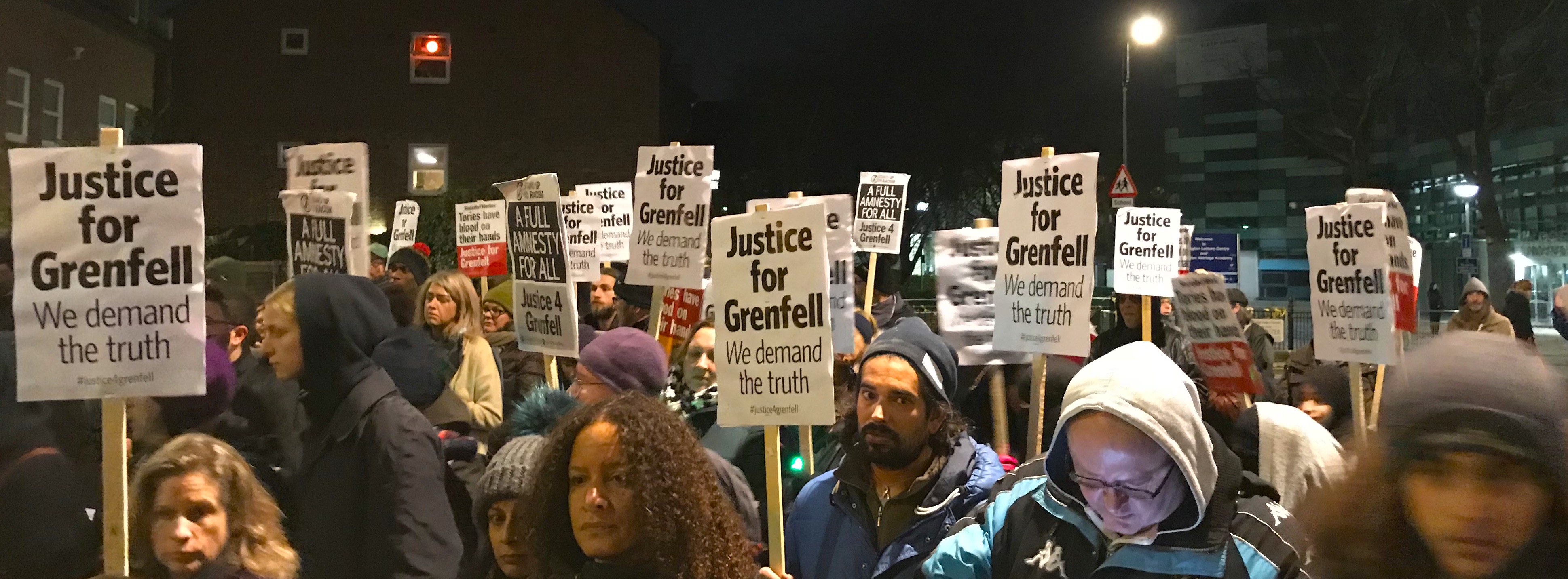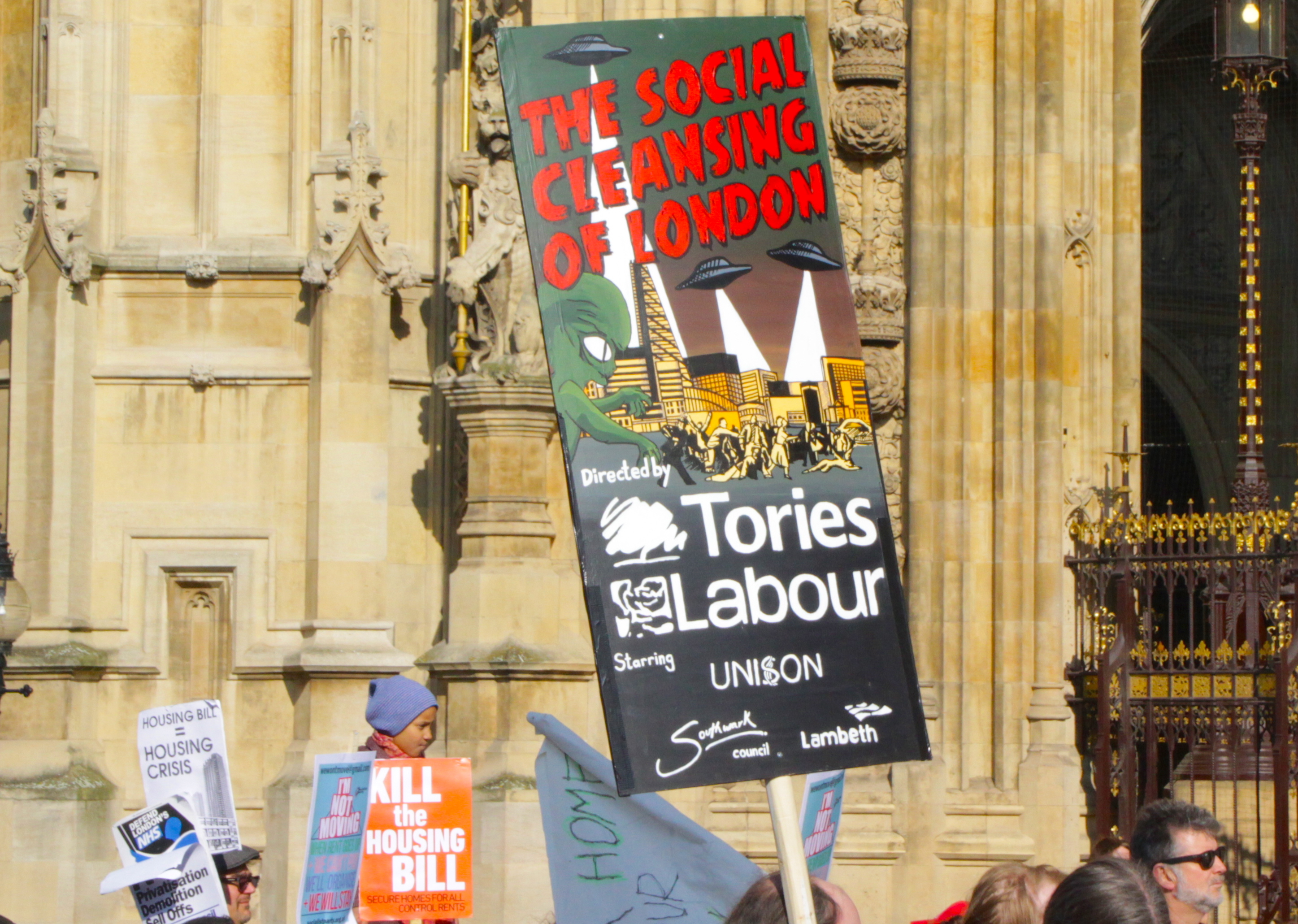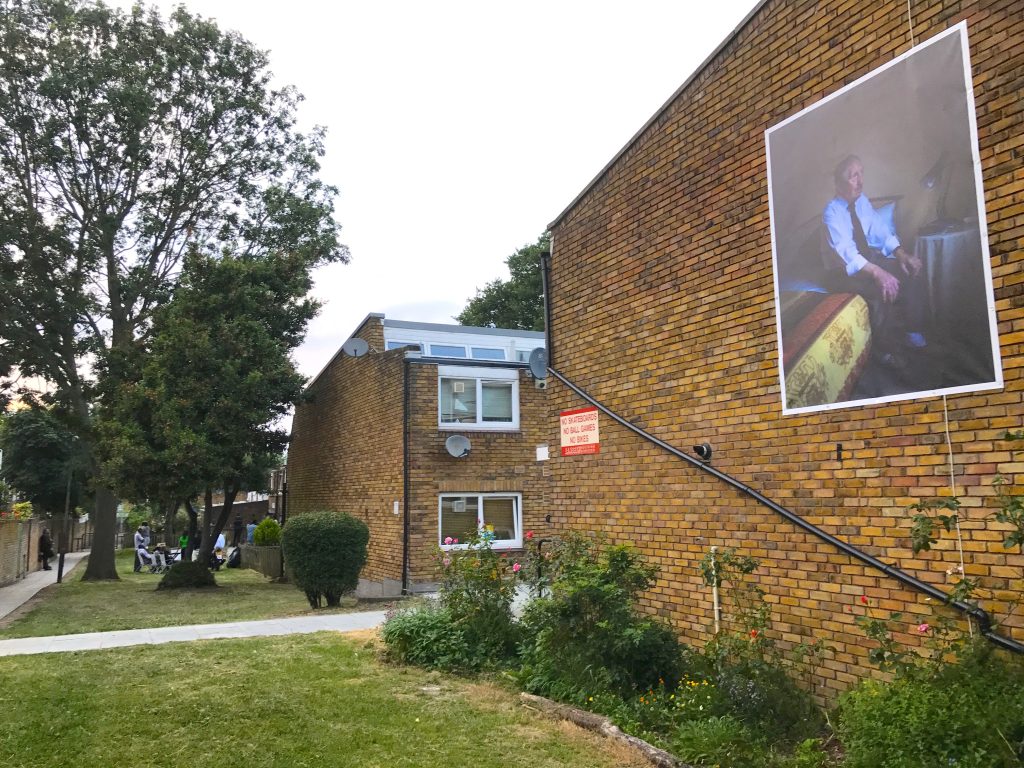
Concrete Soldiers UK

*
By Paul Coleman
*
Londoners who live on council estates are ‘not worth the land they live on’, says Concrete Soldiers UK (dir. Nikita Woolfe, UK 2017), an independent documentary.
Nikita Woolfe’s strident 62-minute film condemns developer-led council-backed ‘regeneration’ of London council estates. Woolfe disdains some conventional journalism practice. Woolfe, if asked what the weather is like, is not likely to hide behind the mainstream media’s faux objectivity and whimper ‘some people say it’s sunny whilst others say it’s raining.’ With Concrete Soldiers UK, Woolfe simply looks out of the window and tells an observed truth that, in fact, it’s pouring with rain; a toxic regeneration rain that socially cleanses London of thousands of working class people.
Indeed, Woolfe chooses war rather than stormy weather as the main analogy to describe what is happening to London’s council estate tenants and their established communities. The film’s narrative is that council estate regeneration resembles a war being waged against working class Londoners; a war secretly plotted in corporate boardrooms, silently executed in town halls and largely ignored by the mainstream media. The warlords, according to Concrete Soldiers UK, constitute a powerful alliance of global real estate investors and locally elected London remnants of the social democratic New Labour cult once headed by Tony Blair.
*
Benevolent v malevolent
Chief amongst these remnants are locally elected politicians like Fiona Colley and Alan Strickland in Haringey, Peter John and Fiona Colley in Southwark, and Lib Peck in Lambeth; powerful London regeneration field marshals who do the bidding of global property capital rather than serve their electorates and council taxpayers.
Woolfe’s small budget, big-hitting documentary says this alliance wields council estate regeneration as a weapon. Regeneration evicts council tenants and dispossesses leaseholders, an outcome that often compels many to leave London. “I didn’t understand why houses were being demolished but people couldn’t go back and live in the newly built flats,” says Woolfe, speaking to an audience of council tenants and residents before the film’s premiere at the Cinema Museum* in Elephant and Castle (Friday, 8 December).
Councils and developers propagandise their war as benevolent ‘regeneration’ that delivers new homes, jobs and economic growth. But resistant tenants and residents, the chief focus of Woolfe’s film, denounce this form of regeneration as an agent of dispossession, displacement and malevolent ‘social cleansing’.
To achieve the alliance’s war aims, an army of media officers offer up their social democratic council leaders and regeneration leaders for the mainstream media to interview. Council chiefs, like Peter John and Fiona Colley in Southwark, Liz Peck in Lambeth, and Claire Kober and Alan Strickland in Haringey, frequently herald how they are heroically doing their best, especially as they claim they have no choice but to regenerate council estates in this way. Central government, they say, has cut local government funds and borrowing to the marrow.
Kober and John, for instance, mantra that regeneration – like any form of ‘progress’ – must inevitably disrupt some people’s lives to achieve wider economic and social goals. Regeneration is like making an omelette; a few eggs must be broken. Again, it’s an element swallowed almost wholesale by the mainstream media that has consistently denigrated council estates and their residents for the past twenty years. Rarely, amidst this constant denigration, is the wider and deeper explanatory context offered.
*
Denigration
That context, running throughout Woolfe’s film, does include slashed council housing budgets that deprived estates of maintenance and investment. But it also explains how surging unemployment in the 1980s and 90s devastated working class families and how Right to Buy caused a net loss of council homes. The pernicious spread of needs-based allocation confined council housing to the worst-off and most vulnerable victims of London’s inequitable political economy. Estate populations became transient. Routine denigration of council tenants and their estates continues to precede developer-led demolition regeneration. Refurbishment is dismissed.
Woolfe, in setting out this context, chooses not to directly challenge leaders like John, Kober and Peck – although Southwark Council apparently ignored invitations to appear. By skipping the standard journalism convention of a right of reply, Woolfe’s film overlooks opportunities to prick council leaders’ self-inflated regeneration heroics. Firing tough questions at these powerful characters – a John Pilger approach – might have strengthened the film’s attack on their regeneration puff. Too many Londoners, fed by the common media narrative, still swallow the idea that regeneration delivers inevitable change and universal progress.
But this structured omission aside, Woolfe’s polemically infused journalism reveals regeneration’s false dawns, broken promises and outright deceits. Woolfe focuses on three south London council estates; Central Hill and Cressingham Gardens in the borough of Lambeth, and the Aylesbury Estate in Southwark. Regeneration drops on these council estate tenants and leaseholders threatening to destroy cherished homes, familiar neighbourhoods and to tear apart family, social and community ties.
*

*
Central Hill Estate
For instance, Woolfe captures the turmoil, anger and resistance generated by plans to demolish and redevelop architect Rosemary Stjernstedt’s Central Hill Estate in Norwood. These 450 spacious and airy flats offer spectacular views of London. Unfortunately, residents say Lambeth Council fails to look after Central Hill Estate over many years. Residents’ homes suffer persistent leaks, mould and a host of other reparable problems.
But the council wants to demolish Central Hill, break up the community and sell the land to the highest bidder. Residents battle against the social cleansing underlying this regeneration – but you’re unlikely to read much about their struggle in daily newspapers or see it featured in-depth on BBC London News or the London Evening Standard, the only daily newspaper dedicated to the city.
From this oft-ignored angle, Concrete Soldiers UK tackles London’s housing boom that serves global capital’s interests but that tips working class Londoners into crisis – where many face a chronically deficient supply of genuinely affordable and secure homes. In covering council estate regeneration from this angle, Concrete Soldiers UK swims against a tide of mainstream media coverage that grunges from routine neglect to misrepresentation via corporate strewn propaganda. The free London Evening Standard coins revenue from a weekly property supplement full of adverts for luxury new apartments. Most of its commuter readers on average and lower incomes can only dream about affording the obscenely overheated prices at which the Standard advertises these regeneration properties.
Worse still, mainstream media coverage only sees a housing crisis in terms of supply. Simon Elmer of Architects for Social Housing (ASH), who underpins much of Concrete Soldiers UK’s counter-narrative, redefines London’s so-called ‘housing crisis’ as a crisis of affordability and tenure. Regeneration builds thousands of new homes in London, says Elmer; it’s just that most Londoners on average and lower incomes simply cannot afford them.
Specialist housing correspondents, where they exist – and with the exception of some Guardian columnists – more or less swallow the common narrative that the only solution is to build more homes for private sale in order to increase supply and reduce prices. They accept that corporate-dominated regeneration schemes must demolish council estates and build new luxury homes on publicly-owned land transferred cheaply to private corporate interests. All of this is inevitable, the price of progress, and opposing it is simply like trying to stop night following day.
*
Cressingham Gardens
Woolfe refreshingly shuns this fatalistic common narrative. For instance, her film lifts the lid on a regeneration scenario that threatens the residents of architect Ted Hollamby’s Cressingham Gardens, an attractive, quiet and successful low-rise estate in Lambeth. Real estate vultures crave the estate’s land as it sits idyllically adjacent to Brockwell Park.
Woolfe clips a Lambeth Council cabinet meeting where councillors vote to demolish – sorry, to ‘regenerate’ – Cressingham Gardens with just nods of their heads. Not even hands are raised. These nods sanction an estate regeneration programme that will demolish Cressingham Gardens’ 300 homes. Some 200 council tenants and 73 leaseholders face the loss of their homes – built between 1971 and 1978 – and their tightly knit community. But Cressingham residents fight back and challenge the regeneration plan in the courts.
Woolfe could have made the same kind of film about regeneration nightmares facing council tenants and leaseholders on dozens of London council estates and in other working class neighbourhoods. Elmer and ASH constantly depict a list of some 40 council estates ‘socially cleansed by Labour councils’, including Balfron Tower, Carpenters, Holly Street, Love Lane, Nightingale, Ocean, Pepys, Robin Hood Gardens, Thamesmead and Woodberry Down; and, that list does not include estates, like Grahame Park and West Hendon, undergoing regeneration by Conservative councils.
Elmer, as a talking head in Woolfe’s film, cuts a more depressing figure, rightly drawing attention to a report, co-authored by the Savills global real estate firm and by the Institute for Public Policy Research think-tank, which says council estates sit on the greatest source of London brownfield land available for private real estate development. Blairite Labour peer, Baron Andrew Adonis, now chair of the National Infrastructure Commission, points out in the report that ‘Islington Council alone owns about 150 council estates of 50 homes or more on some of the most expensive land in the world’.** Adonis estimates there are ‘perhaps 3,500 council estates across Greater London where ‘development potential is larger still, and local authorities are in a unique position to promote this land assembly’.
*

*
Macintosh Court
However, Woolfe’s concrete soldiers – white, black, young and elderly working class Londoners – are not paralysed with despair. They doggedly campaign and resist despite facing one of the grimmest threats to their existence. For instance, elderly residents at Leigham Court Road, a 1970s 44-flat sheltered residential complex in Streatham, successfully campaign to stop Lambeth Council from demolishing their beloved homes and community.
Residents say Lambeth failed to maintain and repair architect Kate Macintosh’s modernist complex over many years, before trying to use its overall physical decline as a reason for its demolition, a typical sleight of hand used by councillors hell-bent on ‘regeneration’ via demolition and dispossession. “The council tried to trick us because we’re over sixty, as if we’re all idiots,” says one resident. Eventually, Lambeth Council backs down and residents rename the complex after Macintosh, who also campaigned on their behalf.
Macintosh Court represents a rare but precious victory for working class Londoners and shows too that council estate regeneration remains a simple enough story to tell – if you can also catch this bull by the tail. The journalism needed to unearth the story demands hours spent in planning and residents’ meetings, studying dense reports and decoding regenerationspeak. Woolfe invests three years making Concrete Soldiers UK – and that includes a re-working of the film after the disastrous urban nightmare fire at the 24-storey Grenfell Tower kills 71 working class men, women and children on the Lancaster West Estate in North Kensington on 14 June 2017.
“They (the council and management) refurbished the property with a minimum amount of spend,” says one Grenfell resident at the start of Concrete Soldiers UK. “There were no sprinklers in the flats and no proper fire alarm. On top of that, they put on cladding that was a fire risk. The fire should never have happened.”
Unfortunately, it seems the production timeline of Woolfe’s film does not allow it to forensically dissect the sordid prelude to the Grenfell fire, specifically the shabby penny-pinching by Royal Borough of Kensington and Chelsea and crass profiteering on the part of the estate’s management company and contractors. Neither does the film explore in depth the way the local council – the Royal Borough of Kensington and Chelsea – ignored residents’ warnings about perilously compromised fire safety before, during and after the Grenfell Tower’s £10m refurbishment. But Woolfe’s piece places Grenfell within the matrix of council estate regeneration, social cleansing and London’s wider housing inequality – and this is just one reason why Concrete Soldiers UK is a valuable piece of filmmaking.
In November 2016, Joe Delaney, who lives in a block next to the Grenfell Tower on the Lancaster West Estate, posts on the Grenfell Action Group blog: ‘‘It is a truly terrifying thought but the Grenfell Action Group firmly believe that only a catastrophic event will expose the ineptitude and incompetence of our landlords, the Kensington and Chelsea Tenant Management Organisation, and bring an end to the dangerous living conditions and neglect of health and safety legislation that they inflict upon their tenants and leaseholders…Unfortunately, the Grenfell Action Group have reached the conclusion that only an incident that results in serious loss of life of KCTMO residents will allow the external scrutiny to occur that will shine a light on the practices that characterise the malign governance of this non-functioning organisation.’
*
Lakanal House
The decline of the TMO, a not-for-profit private company formed in 1996 to manage the Royal Borough of Kensington and Chelsea’s 9,760 council properties, is a story that council estate residents across London fully recognise. Politicians promised the TMO would be tenant-led with council tenants exercising more control and influence. But this never happened and within a decade tenants were vainly trying to hold the TMO’s board to account over safety, repairs, maintenance, financial practice and governance issues. Tenants began to accuse the TMO of treating them with increasing contempt. Delaney, who saw two people fall from the tower during the fire, says the management company and councillors and council officers were “warned before, during and after the regeneration” about Grenfell’s lack of fire safety. The refurbishment of the Grenfell Tower failed catastrophically chiefly because those with power holding the purse strings did not listen to the people for whom they had a duty of care.
This contempt for council tenants stretched back to the horrible Lakanal House fire in July 2009. Post-Grenfell, councils across the country now pour over largely ignored fire safety recommendations that followed the preventable Lakanal tragedy that killed six people in a 14-storey Camberwell council block in south-east London. After Lakanal, Coroner Judge Frances Kirkham wanted enhanced fire risk assessments, stricter fire safety building regulations and, crucially, to make sure residents know what to do in a fire.
Six months after Grenfell, promises made by national and local politicians – most notably Prime Minister Teresa May – to swiftly rehouse those made homeless by the fire lie exposed as broken and empty. As Christmas 2017 approaches, around 120 households still languish in temporary hotel accommodation or stay with friends. Royal Borough council officers, under new leadership after post-Grenfell resignations, scuttle around Kensington and Chelsea, one of the most valuable real estate areas on the planet, trying to find properties to buy in order to rehouse Grenfell’s traumatised, homeless families.
The right of Grenfell residents to return to homes near to their families, friends, schools, businesses and community is recognised almost without question; and so it must be recognised, even if only to maintain a pretence that a civilised state and society exists in London. But there’s no concealing, as Woolfe’s film shows, the contempt aggravated by a lack of care for council estate tenants that preceded those fires – and it’s a contempt that fuels council estate regeneration too.
Council estate tenants and leaseholders across London recognise this contempt, especially the lack of accountability and transparency by central and local government politicians and bureaucrats when it comes to the repair and maintenance of their estates. Council estate regeneration is also riddled with contemptuously broken promises about full consultation before any demolition, a guaranteed right to return to homes on newly developed estates, and the viable quotients and type of ‘affordable housing’. Politicians and developers often dissolve their regeneration promises citing the excuse of changing market circumstances and hiding their numbers behind a wall of ‘commercial confidentiality’.
*
Aylesbury
Funds raised at the Concrete Soldiers UK premiere are earmarked for leaseholders on the Aylesbury Estate in Southwark. They need the cash to help raise about £20,000 needed to fight a second set of compulsory purchase orders issued against them by Southwark Council. The CPO inquiry begins in January.
Built between 1963 and 1977, the Aylesbury Estate became home to over 7,000 people in 2,750 council homes. The Aylesbury also became a national ‘regeneration’ vanguard symbol in 1997 when newly elected Tony Blair visited the estate to make his first Prime Ministerial speech. Blair told a media scrum: “I have chosen this housing estate…for a very simple reason. For eighteen years, the poorest people have been forgotten by government. There will be no forgotten people in the Britain that I want to build.”
Read carefully with hindsight, the last sentence of Blair’s statement contains some menace if translated as ‘let’s sweep the forgotten people out of London altogether’. Routinely denigrated by both politicians and news media as a ‘sink’ estate beset by anti-social behaviour, crime and violence, the court of public opinion is finessed to accept regeneration via demolition. Much of crime and violence is actually wholly fictitious, as Southwark Council reaps tidy sums from filmmakers who use the Aylesbury – and the neighbouring Heygate Estate – as backdrops for ‘gritty’ violent cops and gangs movies and soaps.
Enter Notting Hill Housing, originally philanthropic but now profit-driven. With the backing of Southwark’s Labour leadership, NHH remains hell-bent on demolishing the Aylesbury, ignoring resident council tenants and leaseholders who vote overwhelmingly in 2005 for estate refurbishment. Twelve years on, regeneration has already begun to replace the Aylesbury’s 2,750 council homes with 3,575 new homes. Only 1,750 will be ‘affordable’, incurring a net loss of up to 1,000 affordable and secure tenure social rented homes.
Leaseholders like Beverley Robinson, who attend the film’s premiere, face the loss of their homes and levels of compensation paltry in relation to the cost of new homes going up on the Aylesbury. In this way, the net loss of council homes makes the Aylesbury’s regeneration very similar to that which destroyed the neighbouring Heygate Estate where 1,212 council homes were lost with only 79 planned as replacements.
Hence, Woolfe’s concrete soldiers continue to resist this nigh-silent war being waged against them. Publicly funded Southwark Council’s expensive publicly funded legal team will have to prove to a publicly funded planning inspector that its publicly funded regeneration of the Heygate Estate and publicly funded CPOs will be in the ‘public interest’. They will admit that leaseholders like Robinson will not be able to buy outright a new home on the new Aylesbury development. But they will argue that the leaseholders should consider using their compensation to buy a share of one of the new ‘low-cost’ shared ownership ‘affordable’ homes being delivered.
Robinson says £100,000 compensation is way short of the £500,000 asking price commanded by the first completed Aylesbury phase. “I would be paying my mortgage all over again,” says Robinson, who says why should she buy a share in a new flat when she fully owns her existing home. “It’s sad to see all these people dispersed and all these empty buildings. People are homeless but these flats sit here empty,” says Robinson, watching as her neighbours are decanted. “But it’s still my home, and I love my home.”
*
Moved on
By giving voice to council estate residents like Robinson, Concrete Soldiers UK qualifies as a genuine protest film, an anti-war film even. Like many such protest films, it echoes with an anthem, Moved On, a stirring folksong written and performed by Jimmy Aldridge and Sid Goldsmith. The duo are inspired by the residents of Newham in east London, particularly the Focus E15 women campaigners, who are battling social cleansing where a Labour council seeks to relocate long-term residents as far afield as Birmingham, Manchester and Stoke-on-Trent. “Whilst we understand the housing crisis has no easy solutions, the injustice of ripping people from their communities cannot be the answer,” state Aldridge and Goldsmith on their website.
As for the regeneration industry’s war against council estate residents, people might be forgiven if they still fail to see any signs of this ongoing conflict when they look out of their windows. However, there are four sure ways to see evidence of this war. Firstly, take London’s tube to Latimer Road. Step onto the platform and look up at the hideously charred carcass of the Grenfell Tower. Then read the written residents’ warnings that councillors and officers ignored leading up to the fire.
Secondly, take a walk around your neighbourhood and look up at the cloned, often-gated tower block developments, full of ‘boxified’ hutch apartments that make every regenerated and hideously overpriced neighbourhood look exactly the same. Thirdly, find out why the people you used to see walking and working in your neighbourhood have been moved on, unable to afford those hutches.
Finally, interrupt your box set watching and watch Concrete Soldiers UK. The film is being screened tonight (Monday 18 December) in Deptford. Woolfe plans further screenings for tenants and residents associations across London.
Ignore the absence of interviews with developers, housebuilders and councillors and the high opinions they have of their opinions. They’ll be on TV news and politics chit chat shows soon enough revealing their high opinion of their opinions.
Instead, absorb Woolfe’s refreshing amplification of the voices of working class Londoners; the people subjected to developer-led, council-backed regeneration – one of the most perniciously anti-democratic and inhuman facets of London’s unequal political economy.
*

*
Source and Links
* The Cinema Museum faces possible eviction in March 2018. The NHS, as landlords, are selling the building.
** City Villages, More Homes Better Communities, Institute of Public Policy Research, London, 2015.
Concrete Soldiers UK (dir. Nikita Woolfe, UK 2017, 62 mins, PG).
Showing tonight in Deptford, south London http://deptfordcinema.org/new-events/concretesoldiers
Aylesbury Leaseholders http://www.aylesburyleaseholders.org/
Moved On by Jimmy Aldridge & Sid Goldsmith http://www.jimmyandsidduo.com/copy-of-videos
*
© London Intelligence. All Rights Reserved.
